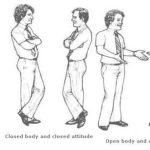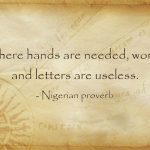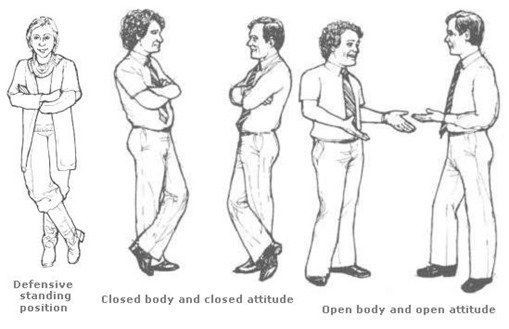In the past, communicating in other ways aside from using words was a norm. Your mother stares you down at the slightest attempt of trying to collect money from a stranger, and you know that trouble looms if you eventually accept it. She blinks her eyes in an attempt to tell you to be careful, or you will be penalised.
In a Nigerian home, before a child becomes a teen, he or she understands all sorts of facial expressions and body language. They were used frequently, and body language had become part of their lives. It helped them communicate without saying a word, and they in turn, tried it on their children. The result? Faster and effective communication.
Nowadays, it has become increasingly difficult to communicate using body language and facial expressions. However, some situations call for using this, hence the need to present a guide to make it easier to understand different forms of non-verbal communication.
Table of Contents
What is Body Language?
Body language is using behavior, expression, and posture to communicate. Sometimes, body language also includes facial expressions. The saying “action speaks louder than words” is accurate most times, because the real emotions and feelings of the speaker or someone communicating something are usually expressed through body language and facial expression.
For example, if there’s a celebrity known for his handsome smile and attention to his fans, then stops smiling as he used to and starts showing a lack of attention or becomes absent-minded.
Without saying a word, his fans will know something is wrong and try to guess the cause of his problem. Whether he is battling with a problem he cannot easily talk about, or he was dating someone and his heart has been broken, or he is under immense pressure or battling depression.
The ways to understand a person’s unspoken words is to understand what different expressions and body language mean, interpret them as a whole and not individually, and connect the person’s past behaviors and actions to their present action. What are some specific examples?
Read also: 11 Effective Communication Tips for Nigerian Married Women.
Body Languages and Facial Expressions and What They Mean
The following are questions to ask yourself if a person is communicating with you, especially if you just asked them a question:
Is the person relaxed? Is there minimal physical contact? Is there eye contact? Are the individual’s replies quick? If the answer to these questions is yes, it means that the recipient of your conversation has nothing to hide. When it comes to eye contact and facial expression, take note of the following:
- Rolling of the eye can mean boredom or annoyance.
- Looking away can mean shyness. Sometimes, you can confirm that someone is shy when the person plays with anything he or she lays his or her hands on.
- Staring anywhere else except you or looking at his or her phone can mean boredom or a lack of interest. Sometimes, it means what you are saying does not matter to the person.
- Maintenance of regular eye contact means the other person is interested in your words.
- Scrunching or squeezing up your face can express impatience, disbelief, or disgust.
- A smile can indicate interest or agreement. It can also mean an indication of flirting.
- A raised eyebrow will indicate disbelief or surprise.
- Eye gazing, especially for long, can indicate one trying to look deep into the other person’s inner emotions. Sometimes, it can indicate a lack of trust in what a person is saying or can reveal affection.
When it comes to body language, be alert to the following and what they can indicate:
- Depending on what your conversation started with or is about, twisting the hair can either imply shyness or a sign of flirting.
- Using hand gestures shows confidence and proves you are sure of what you are saying. It can also tell the other person or persons that what you say is the truth. However, using hand gestures excessively can indicate pride.
- Folding hands can indicate annoyance or can be a form of defense.
- Tapping one’s feet restlessly on the ground and biting nails can show anxiety and is an action that can indicate fear.
- Sitting upright indicates interest in the subject matter and an eagerness to know more.
- A shaky voice indicates fear.
- Unnecessary physical contact can be a sign of flirting and is an indication that one is not confident enough.
- Silence in a conversation by one of the parties is called silent treatment and can indicate a lack of interest. It can also serve as a reply. When one person asks a yes or no question and nothing is said, it is often taken as saying yes.
- Shifting on a sit frequently can show a lack of comfortability.
- Holding one’s head up high indicates confidence.
Sometimes, however, a person’s words and actions do not match. Someone can be very angry and squeeze his or her face but also speak softly at the same time, making it hard for the other individual to decipher what the person is thinking and feeling. This is where it becomes important to weigh and carefully think of what to say and how to express oneself so that one does not confuse others.
Read also: 8 Ways to Develop Effective Business Communication Skills.
Keep these in mind to avoid causing confusion to others;
- As much as you can, avoid speaking when hurt, tired, or angry, so you don’t say things you do not mean.
- Understand yourself. How do you convey your emotions, be it pain, happiness, or hurt? When you understand these things, matching your words with the right actions will be easy.
Read also: African Languages in the Digital Age: Revitalization and Preservation.
Conclusion
With the millions of emojis used in texts and a decreasing level of social intelligence due to less human interactions and more digital interactions, understanding body language and non-verbal communication will make you understand people and avoid misreading them. You will also experience long-lasting friendships.
Join our Whatsapp community, where we share life-changing opportunities that will benefit you. Also, subscribe to our newsletter to receive notifications of our latest valuable posts.
Edited by Oluwanifemi Akintomide.
About Author
- Stella Agboola is a content creator who specializes in the field of health and disease. She also has a personal blog where she discusses social-related content. In addition, she is an avid reader of domestic thrillers and African novels. At her leisure, she reads books and listen to podcasts for information and entertainment.
Latest entries
 LifestyleNovember 19, 2023Understanding Body Language and Facial Expression – A Simple Guide to Social Intelligence
LifestyleNovember 19, 2023Understanding Body Language and Facial Expression – A Simple Guide to Social Intelligence
 CareerSeptember 14, 2023Video Conferencing Etiquette Tips for Nigerian Employees
CareerSeptember 14, 2023Video Conferencing Etiquette Tips for Nigerian Employees LifestyleSeptember 1, 2023Nigerian Proverbs and Wisdom: Lessons for Modern Living
LifestyleSeptember 1, 2023Nigerian Proverbs and Wisdom: Lessons for Modern Living

